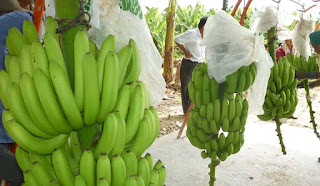Upward Curve
Piura's banana opens its way fastly in the international market.
LOS ANGELES, Calif. -- American people look like to love banana, so Dominican Republic seems to be the spoiled one. The Caribbean country is the main provider of the fruit, Peru is just behind. The United States International Trade Commission reports that Peru's banana exportation was US$ 53 million in 2015. U.S. is the main market for Peru.
According to Peru's Foreign Trade Office in Los Angeles, it could displace Dominicans in the short term if it makes the productive chain more competitive, what means a more attractive value added, and researches to avoid the plagues can decimate the production. In fact, one of the challenges for Peruvian producers is keeping black sigatoka (Mycosphaerella fijiensis) away, a very common disease in Dominican Republic and Mexico as well, the other fruit producer. Both combined represent the half of the world's share.
At least in the U.S. West Coast, the banana is consumed mostly in its dehydrated version because it can be added to snacks like energetic bars or juices, then comes the fruit as we know, what it's better if organic. FACTORTIERRA asked some consumers in The Big Orange if they can identify The Peruvian banana at supermarkets and said yes - each fruit has clearly marked its origin place and the organic tag just in case.
The u.S. Organic Trade Association assures the organic banana market represents US$ 165 million. However, there are two countries those dispute the leadership in fruit exportation too, India and Ecuador.
The banana (Musa sp, Musa porparadisiaca) is the most popular intertropical fruit in the world. It comes out from Asian Southeastern, is sowed and cropped in virtually everywhere with warm and relatively wet weather - 170 countries to be more accurate.
It is supposed the cropped
strain in Peru fluorished initially in India. progressively it was spreading
across the west until reaching Canary Islands, where it was exported to La
Española Island in 1519. Currently that piece of land is shared by Haiti and...
Dominican Republic.
By the way, the banana word is
possibly Arabian meaning 'fingers'. The mature fruit is rich in fiber, easy
metabolism carbohydrates, potassium, A & C vitamins, and it doesn't have much
sodium nor fat. Its fifth part is dry matter that supplies about 120
calories. Chira Valley
(Piura,
Peru) has already sowed banana several decades ago but pretending to satisfy the
domestic market indeed.
When ecuadorian banana
producers noted they can not fulfil their exportation share and came into the
Chira to look for who could provide the fruit in mid-1990s, it was when
exporting potential became clear. The problem was the local producers sold
individually, what allowed a large speculation range and few gains.
Organized and managed production by Chira's banana farmers started September 2001, they are part of the international fair trade system more than a decade ago. Currently, they export to Japan, europe, Canada and the U.S.
It is estimated that in Piura Department 52 sq mi or less than 1/500 of regional territory are sowed with organic banana, less than 1/70 of Sullana Province's territory, where plantations are mostly concentrated. Until mid-2015, the business benefit 6500 farmers and 30,000 families across Piura, mainly the coastal part.
The most cropped type is Cavendish-Valery. It is placed into 40,6-pound boxes, those cost US$ 3,80 at the plantation, until US$ 11,70 when reaching the seaport for better. It has grew up 23% between 2007 and 2015, what places it as the Piura's most profittable productive chain, according to organized banana farmers. Only between 2014 and 2015, it grew up 19% boosted by the international demand, what means US$ 143 million income after sending 188,000 tons, according to Piura Banana technical Board. Those numbers include delivers to the U.S.
According to Peru's Ministry of Agriculture and Irrigation, national organic banana exportation grew up 95% between 2010 and 2015 and 22% between 2014 and 2015. In the same way, it reported that then each pound was paid US$ 0,23 in average. FACTORTIERRA learns that same pound can cost US$ 0,99 in average when reaching L.A. supermarkets. That same pound can cost US$ 0,17 in average at outdoor markets across Piura Coast, plus freshness as competitive advantage.
The organic banana business in Chira Valley has created a sort of competition among the farmers going from whom is sold to where it's sold.
"... We're the company working
with a larger clients diversity in Europe as well as United States," Samán-based
Appbosa Coperative (Marcavelica, Sullana) affirms. Established February 2003, it
operates in 4,5 sq mi that allows it to reach until 23 weekly containers,
according to its website.
Its first client was Dole that
bought its production locally but under the transnational brand. Today it
exports directly and has the worldwide recognized Chiquita Banana among its
buyers. In Salitral de Sullana, Solidarian Banana Farmers Association's
(BOS like in Spanish) 2000 families became exporting 27 tons to Portugal, the first organic banana
shipment in that market according to Peru's Industry, Foreign Trade and Tourism
Ministry. It was projected that BOS, established 2003, opened a market in Spain
in 2017 Winter-ending but it's unknown how it worked on after heavy rains from
Having a market that seems to grow up, what could blur the success of Chira banana farmers, including black sigatoka? Specialists commented to FACTORTIERRA that producers have to watch the bananas come out and arrive without any bit of chemicals. One only trace of some forbidden substance and "the market brings them down."
Meanwhile, it's time for some snack beneath California's Sun. Will be a good reason for going to the nearest supermarket and getting some bananas?
© 2017 Asociación Civil Factor Tierra. All Rights Reserved. The photographs featured on this entry are El Regional de Piura







Comentarios
Publicar un comentario